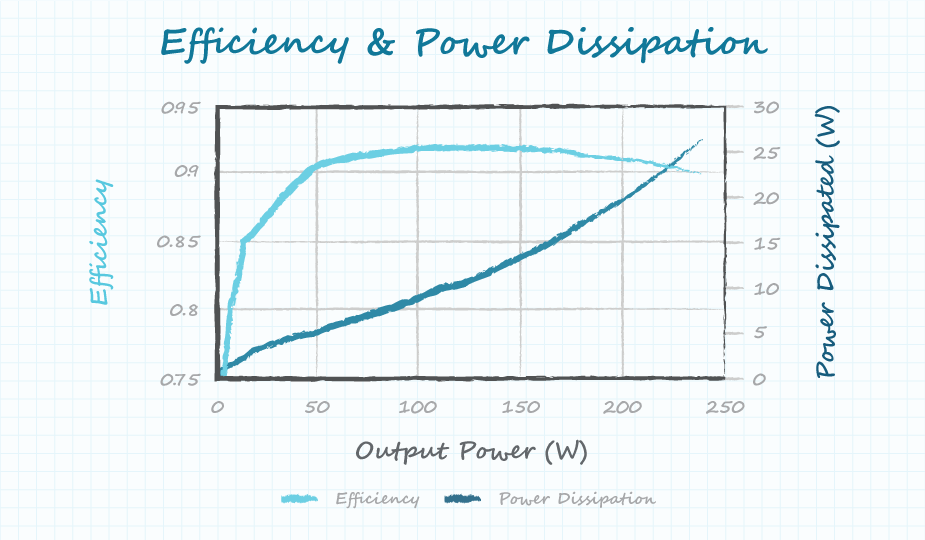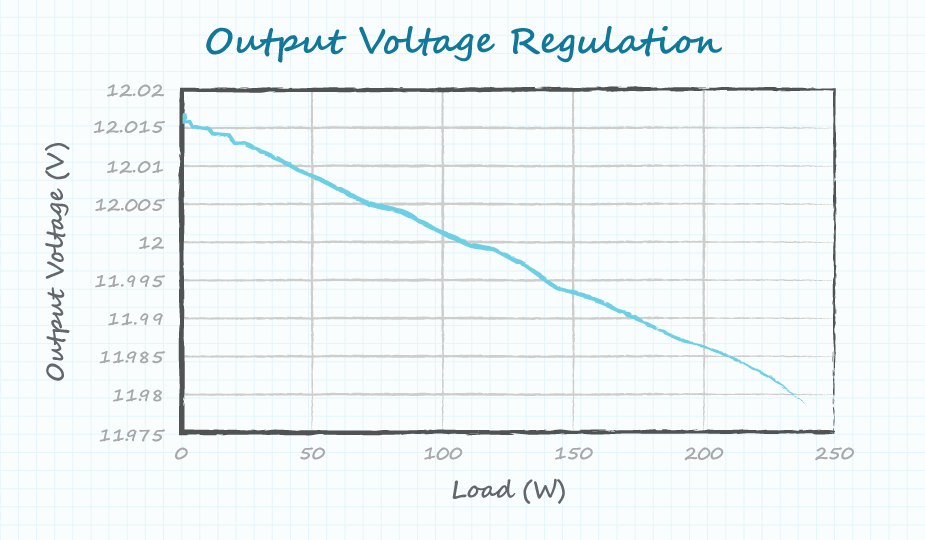what happens to an aquifer if there is a hight output demand
Welcome to Function 2 of our "Pushing the Limits" serial, where we delve into a question we hear often at CUI, "What if I operate my power supply outside of a certain specification range?" In Part 1 we covered the input voltage specification. Now in Part 2 we will look at output electric current and the problems that can occur when exceeding the output current specification.
Read Part 1 of our "Pushing the Limits" serial on input voltages
Read Role three of our "Pushing the Limits" series on operating temperature
Output Current Limits
The rated output current is one of the most important specs when selecting a power supply. Information technology plays a large part in determining the size and price of the unit, which leads designers to cull power supplies that have merely enough current to meet their requirements. In these cases, it is tempting for a designer to select a power supply that addresses the "normal" operating current in guild to save on toll and size, while assuming that it can handle the peak currents for a short time. This same line of thinking goes for the minimum current limit too. However, exceeding either maximum or minimum electric current specs tin lead to several issues including degradation of operation, protected shutdown, or fifty-fifty component failure.
Exceeding Output Electric current Limits – Performance Issues
Efficiency, regulation, and electromagnetic emissions (EMI) are some of the most important specifications affected when operating a ability supply outside of its rated output current.
As the output current goes upwardly, and then does the output power. If the efficiency were fixed beyond load, the additional electric current would atomic number 82 to a linear increment in power dissipation within the supply. This added ability loss causes an increase in component temperature ascent which can lead to thermal failure. In practice it is unlikely that the efficiency will remain abiding and, equally shown in the graph beneath, it is common for a power supply to reach summit efficiency before maximum load, resulting in efficiency that decreases past its rated current. This leads to an exponential increase in ability dissipation with respect to load increases, causing the maximum temperature to drop much faster than if the efficiency were constant. In add-on to the thermal concerns, the dropping efficiency could crusade the power supply and/or system to neglect efficiency regulations. As the graph further shows, when operating the ability supply xx% beyond the rated load of 200 W, the efficiency drops a total percentage point below its 91% specification. This results in a 30% increase in ability dissipation.

Load regulation is another problematic spec when operating exterior the rated output current. The load regulation tells the user the maximum amount that the output voltage tin exist expected to change as the load changes betwixt no load and full load. The graph below shows an example of the load regulation of a 200 W ac-dc power supply. This particular power supply has an output voltage that drops with increased current. Yet, this is not always the case as some power supplies volition see the output voltage increase with load. Either way, operating outside of the specified current range may cause the output voltage to motility outside of its load regulation specification, leading to problems in applications that cannot accept voltages outside of this range.
Applications with tight input ranges frequently take advantage of external voltage sense connections, which will regulate the output voltage at the load rather than at the output of the power supply. With external sensing, a drop in output voltage that would unremarkably occur between the ability supply and load is compensated by increasing the output voltage of the supply. As a result, there is often a specification for the maximum voltage that can exist compensated for in order to prevent damage to the power supply due to an increased voltage.

In power supplies with a minimum current rating, operating below this limit may also cause the unit of measurement to operate exterior of its regulation specification. These power supplies are often small, less expensive units with simple command schemes that are non designed to handle the issues that occur at light loads. A minimum current can also be specified in multiple output power supplies, which is needed to regulate the secondary outputs within their specified limits.
A final, less obvious outcome related to output current is increased EMI. Switching power supplies are electrically noisy devices and a lot of board infinite is devoted to filter components to assistance them meet regulatory requirements; unremarkably just plenty to pass the required testing. Even when operating within the specified load range, issues still arise when used with certain loads. In general, the magnitude of EMI is expected to increase with load and operating beyond the maximum load can button EMI above the failure threshold. This is further compounded if the filter becomes less effective at college loads. Increased currents and/or temperatures in these components can also change their values and change the filter's response.
Exceeding Output Current Limits – Protected Shutdown
The specification related issues described in a higher place all assume that the power supply will allow the user to operate to a higher place the maximum output current. Withal, most ability supplies are equipped with some class of over current protection that prevents the load from exceeding a certain current threshold.
Some ability supplies have a well-defined threshold closer to the rated output beyond which the over current protection kicks in. Users that attempt to size their power supply for nominal current and let peak current needs exceed the electric current rating may also see the output shut downward due to this protection.
Other protection schemes have wider tolerances that let the load to significantly exceed the maximum rated output. Threshold differences betwixt individual supplies can cause issues if the protection is enabled in some supplies simply not in others. If the output does not shut down, the supply will operate in a higher place its maximum current resulting in spec related issues or failure.
In improver, more than circuitous power supplies offer protection confronting current falling below the minimum rating while others volition disable operation completely under these conditions. Ability supplies that cannot reliably regulate themselves at light loads will lead to excessive voltage on the output which could likewise trigger a protection.
Exceeding Output Current Limits – Component Failure
While the previous issues will not always crusade a failure or harm to power supply components, many components volition experience extra voltage and/or current stress as a upshot of the increased load electric current, putting them at greater chance.
With increased output current comes similar increases in component currents throughout the power train. Components such as MOSFETs, diodes, resistors, and even copper traces will see increased power dissipation and heat considering of the increased current. Diodes and other components with a fixed voltage, volition observe a linear increase in power dissipation, while MOSFETs and components with resistive elements volition show an exponential rise in power dissipation with respect to load increases. In both cases this volition atomic number 82 to increased temperature rise, reduced reliability, and increased risk of failure.
Magnetic components such equally chokes and transformers, while experiencing increased conduction losses like the previous components, may also encounter increased core loss and exist pushed into saturation, producing further losses and heat generation. Saturated magnetics could also cause the ability supply to terminate functioning or generate increased currents in other components, such as the MOSFETs and diodes. For example, in a buck converter, the ripple current is directly related to the inductance. When the inductance starts dropping the tiptop currents in the MOSFET and diode volition increase every bit a consequence.
In addition to discrete magnetic components, there are besides parasitic inductances, such as the leakage inductance of the transformer. These parasitic components cause voltage spikes when the switch changes state and the magnitude of this spike increases with load. In the example of the transformer leakage, the voltage spike is practical across the MOSFET and may cause it to fail if besides large. Other components, like those that sense voltages and currents, will sense these voltage spikes which volition upshot in the controller receiving incorrect voltage and current information – leading to poor performance or failure.
Conclusion
Ability, size and toll are all important factors when choosing a power supply. Unfortunately improving i often inversely affects the others, with more than power typically meaning a larger and/or more expensive ability supply. Even and then, users will oft try to force all iii factors opening themselves up to potential issues. The output current is one such area that affects but about every component in the power supply. Some effects are obvious while others are easily overlooked and cause immediate or long-term issues. Before operating outside of the output electric current rating of a power supply the user should consult with the power supply manufacturer to understand the risks of doing and so or to seek out an alternative solution.
Testing & Failure Analysis
You May Also Like
Have comments regarding this post or topics that you would similar to come across us comprehend in the future?
Send us an email at powerblog@cui.com
Source: https://www.cui.com/blog/what-are-the-drawbacks-of-exceeding-a-power-supplys-output-current
0 Response to "what happens to an aquifer if there is a hight output demand"
Postar um comentário